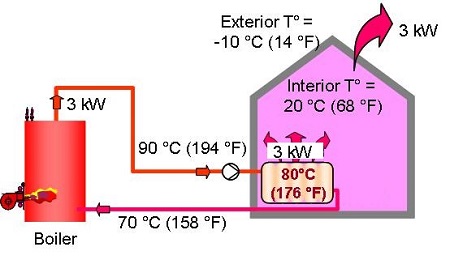To maintain its heating output, the emitter must be continually supplied with hot water. To do this, water at the emitter outlet is recuperated, to be re-heated by a heat generator (usually a boiler) before being sent back through the emitter.
To maintain the temperature of a room with heat losses of 3 [kW], we can therefore:
- Install an emitter with a temperature and surface giving an output of 3 [kW].
- Supply the emitter with a water circuit which is re-heated by a boiler capable of giving it 3 [kW] of heat (ignoring pipe-work heat losses).

Start the film below, and watch a general presentation of hot water heating systems.
« Heating and Hydraulic simulator »: http://lebatimentperformant.fr/librairie/produit/apprendre-le-chauffage-a-eau-chaude-et-l-equilibrage-hydraulique-sur-simulateur-le-simulateur-seul/520
Question
The 3 rooms below are exactly the same and maintained at a temperature of 20 [°C] (68 °F) by 3 emitters with very different surface areas and temperatures.
In winter, is the energy consumption of these 3 rooms very different?

No, at a first glance, energy consumption is identical because the 3 rooms have the same heat losses and are heated to the same temperature.
Fundamentally, it is not the type of emitter which governs consumption for heating, but the building heat losses.
Whatever, the heating system’s job is to distribute through the building a quantity of heat, equal to that lost through heat losses.
To reduce the amount of heat required, there is only one real solution: reduce heat losses and therefore insulate the walls.
The fact that in one of the above systems, it is necessary to heat water to 100 [°C] (212°F) and only to 40 [°C] (104°F) in another is a minor difference at first glance.
“Seen from the boiler” it is not the heating of water to 40 or to 100 [°C] (104°F or to 212°F) which is important, but to give to the water the amount of heat lost by the emitters.
Of course this amount corresponds to the heat losses and is therefore exactly the same if water is at 40 or 100 [°C] (104°F or 212°F).
On the side, there will be some differences however:
– It will be possible to heat the room, fitted with emitters at 40 [°C] (104°F), a little slightly less, because they will be more comfortable (see section “Emitters Technology”).
– The use of water at 40 [°C] (104°F) permits the use of energy efficient devices on systems, such as condensation boilers and heat pumps.
We have now grasped what a hot water heating system is. There are, of course, lots of other elements to discover, which will be the subject of other sections.
